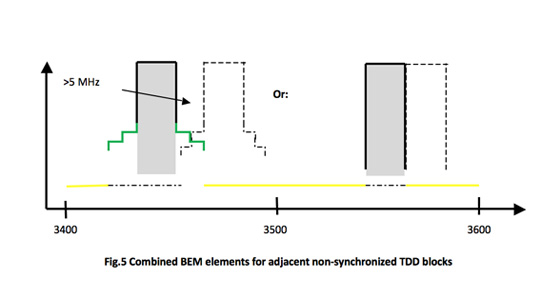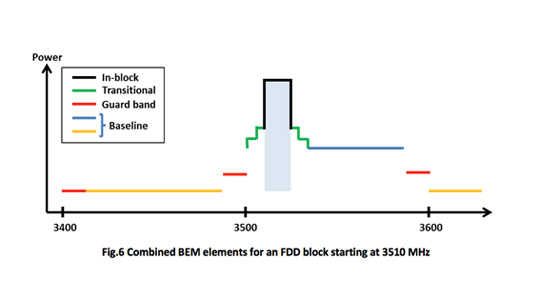ECC completes regulatory framework aimed at maximising the efficiency of future mobile broadband deployments in the 3400-3800 MHz range
In its February 2012 Newsletter, the ECC described how the first set of technical and regulatory arrangements would be implemented in order to open up the largest frequency band (3400-3800 MHz, which is partly harmonised) for International Mobile Telecommunications (IMT) and, possibly, for other mobile broadband applications. In this issue of our Newsletter, we’ll have a look at the ECC’s final steps towards making this large amount of still partly under-used spectrum open for future, truly broadband, mobile applications.
It took the ECC slightly over two years to completei its regulatory update and relevant technical work for the 3400-3800 MHz 'mobile' band since the adoption at its plenary in December 2011 of a Decision on harmonised frequency arrangements for mobile/fixed communications networks (MFCN) for this band (ECC/DEC/(11)06).
As explained in our earlier issue, really high-speed mobile broadband applications (such as HD-video streaming and high-quality video calls) require significantly larger frequency channels and a greater overall amount of spectrum, and this demand can only be satisfied in relatively high (compared to those currently used) frequency ranges offering the needed bandwidth. However, this still brings challenges; first of all, ensuring compatibility with other incumbent users of spectrum.
This important requirement triggered the revision of the (then) existing ECC regulatory framework for the 3400-3800 MHz band which resulted, as a first step, in the development of a harmonised frequency arrangement for MFCN, including IMT, utilising larger channel bandwidths. Now, the ECC has largely completed its work on the second essential element of the modern regulatory framework for MFCN, namely the Block Edge Mask (BEM). In order to increase the efficiency of spectrum use, it has also developed a new technical Report dealing with the 'Time Division Duplex-Time Division Duplex' (TDD-TDD) co-existence scenario.
However, the harmonised frequency arrangement (i.e. the band plan) agreed by the ECC in December 2011 was earmarked for review in 2013 in order to identify a preferred harmonised frequency arrangement (either Time Division Duplex (TDD) or Frequency Division Duplex (FDD)) in the lower part of the band (3400-3600 MHz), and the ECC has now completed this task.
After several rounds of 'hot' debates within its specialist project team (ECC PT1 responsible for IMT matters) and an extensive questionnaire carried out by the European Communications Office, the ECC decided not to create a single "harmonised" arrangement. Instead, it favoured following an earlier approach used in ECC Decision (09)03 on 800 MHz, where "preferred" and "alternative" frequency arrangements were defined. From one side, this approach provides guidance to regulators and to the market, but on the other hand it keeps some degree of national flexibility necessary to maintain the competition at a high level. Thus, the ECC decided that TDD was the "preferred" frequency arrangement with FDD declared as an "alternative" for the 3400-3600 MHz sub-band and ECC Decision (11)06 was amended accordingly (the upper sub-band 3600-3800 MHz was initially unanimously supported for exclusive TDD use and was already "harmonised" for TDD in the original Decision).
The final frequency arrangement for the whole band now looks as shown in figures 1 to 3 below:
The other milestone in improving the regulatory framework for the 3400-3800 MHz band was the adoption by the ECC Plenary in March 2014 (as a new element within the updated Decision) of a Block Edge Mask (BEM) out of the pre-defined BEM elements, namely: in-block, baseline, transitional region, guard bands and additional baseline (for protection of military radiolocation systems below the 3400 MHz boundary).
The developed BEM is applicable to MFCN base stations with different power levels (i.e. macro, micro, pico and femto BS) and is assumed to allow co-existence between MFCN applications in the whole 3400-3800 MHz band (the actual BEMs for TDD and FDD modes will be combined out of the pre-defined emission levels for each of the BEM elements carefully described in the appropriate tables provided in an annex to the updated Decision).
Within the TDD arrangement, different emission levels are applicable for the same BEM elements depending on whether the adjacent in frequency TDD networks are synchronized ("synchronized operation" means that no simultaneous uplink and downlink occur between any pairs of cells which may interfere with each other in the same band). Examples of combined BEM elements for adjacent synchronized and non-synchronized TDD blocks are shown on figures 4 and 5 respectively. Figure 6 provides an example of such a combination of BEM elements for an FDD block in the lower part of the FDD downlink spectrum.
As regards the ways to increase the spectral efficiency by synchronizing adjacent TDD networks, the provisions of the updated ECC Decision (11)06 are further developed in the draft ECC Report 216 'Practical guidance for TDD networks synchronization' which was subject to public consultation at the time of writing. The draft Report in particular states that a common reference phase clock (e.g. for the start of frame) and configuring compatible frame structures (e.g. length of frame, TDD ratio etc.) are the two conditions which need to be followed on all base stations that may interfere with each other in a given geographical area in order to achieve a synchronized operation.
Further, the 'TDD-synchronization' Report provides a description of the currently available techniques for transmitting a reference phase clock which includes: global navigation satellite systems (GNSS), packet based networks, over-the-air synchronization, and “LORAN” (reference signal transmitters mounted on high towers and based on either Loran-C or eLoran format, depending on the country). It also suggests that when multiple operators deploy TDD networks in adjacent frequency bands inter-network synchronization conditions can be discussed and agreed at a national level.
In addition, the updated regulatory framework for the 3400-3800 MHz band includes guidelines (as a separate annex to ECC/DEC/(11)06) on how to ensure co-existence between MFCN and other services, such as: with Earth stations of the FSS (Fixed Satellite Service) and FS (Fixed Service) stations.
This updated ECC Decision (11)06 provides a much more advanced and tailored regulatory framework for the 3400-3800 MHz band which will be better able to meet the requirements of upcoming mobile broadband applications. It is based on a huge number of technical studies which have been carried out by ECC PT1 within the last two years.
This work has resulted in: ECC Report 203 on Block Edge Mask in the 3400-3600 MHz and the 3600-3800 MHz bands; CEPT Report 049 in response to the EC Mandate on the 3.5 GHz band; and the provision of a technical basis for the update of the relevant EC Decision 2008/411/EC. The updated EC Decision will contain the identical technical elements to the just modified ECC Decision (11)06 and as a result of its binding effect on all the EU Member States will further strengthen the new regulatory framework developed by the ECC.
Taken together, these completed European regulations for the 3400-3800 MHz band pave the way for consumers and other end users to exploit the full potential of new mobile broadband applications while ensuring effective co-existence with incumbent spectrum users.
Didier Chauveau,
Chairman of ECC PT1 - responsible for IMT matters
Alexander Gulyaev
Spectrum Expert, ECO
i Draft ECC Report 216, on TDD Network Synchronization is currently under public consultation, but as an ECC Report it is advisory in nature.




